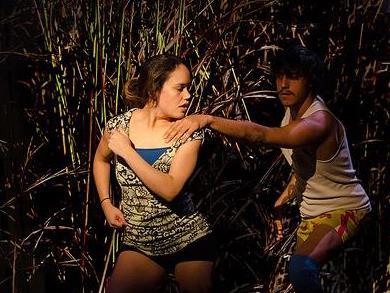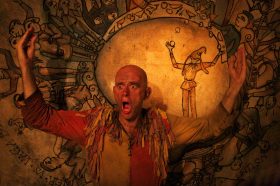Inspired by stories from the homeless population of Darwin and the women of Arnhem Land, choreographer Vicki Van Hout has developed a work of paradise and poverty, violence and depression. Long Grass is the term for Aboriginal people living homeless and on the fringes, yet right in the middle of our cities. Part of the About An Hour series, the work blends text, voice-over and dance, which soon soon becomes an immersive experience.
A visual theme that continues throughout the work is that of weaving. The majority of the characters are introduced when they weave their warp into a screen, which looks like the empty frame of a gate or the back of a chair that becomes a major motif of the work. At first the work begins playfully, but gradually changes to dark and sombre. There is a great sense of community and camaraderie. Van Hout is at her best perhaps showing the small moments of life, with a choreography expressing argument or some minor annoyance, like when a woman creeps off for an illicit cigarette to avoid having to share her last with the gang. Lang’s voices and Phil Downing’s sound design provide an suitably hypnotic sound scape rich with small details and the of tinkering wires and grinding surfaces, effectively mixed with voices and a single harmonica, violin, trumpet or cymbal.
A Wiradjuri woman from central and southern NSW, Van Hout has long been fascinated by the stories of the Yolngu clans of north east Arnhem Land and for this work – which was five years in development – has collaborated with fellow NAIDSA dance graduate and local Larrakia man, Gary Lang. With Long Grass the choreographic connection is at least partly based around the Yolngu women’s traditional practise of ‘parallel walking’ (usually, our walk is oppositional, meaning that our arms swing laterally opposite to our legs).
As Van Hout is also schooled in the traditions of Western contemporary dance, having trained with the legendary Martha Graham in New York, her dance language is mixed and you can see the NAISDA/Bangarra influence too.This also shows with the use of a traditional Aboriginal cloak.
Technically the dancing is superb. The ensemble sequence of the build-up and intensity of the dramatic storm is a highlight, all five dancers spinning and falling to the floor accompanied by the pounding score. Other highlights include some quite challenging, almost dangerous duets, with one extremely violent, another ending tragically.
The looming, dark cluttered set is indicative of the Long Grass of the title but everything appears to be made of plastic, with nothing made from nature here. The screen, woven in the opening scenes, serves as a bed and a shelter and features throughout. It is ingeniously incorporated into the choreography, tripping, trapping and entangling the performers. The two musicians are included at the side and towards the end there is an extended electric guitar solo that sizzles.
Local TV footage incorporated into the work reminds us that some 2000 Larrakia people live homeless, and push other well-known buttons about the scourges of alcohol, gambling and domestic violence. A disturbing ,thought provoking work that deserves to be seen.
Rating: 4 out of 5 stars
Long Grass
Sydney Festival Seymour Centre
Director and Choreographer: Vicky Van Hout
Choreographic collaborator, cultural consultant and voice/sound: Gary Lang
Sound design: Phil Downing
Lighting: Clytie Smith
Dancers: Katina Olsen, Taree Sansbury, Caleena Sansbury, Thomas ES Kelly, Darren Edwards
14-18 January 2015





